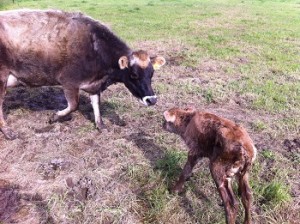Well, much to everyone’s surprise we are still farming after 5 years! Someone said our act of faith in starting a dairy farm at a low time in the industry was like “attempting to jump over 50 cars in a Harley Davidson without any practice”. Its true we bought a going dairy farm but we started from a low base. We had to at least double production to become viable. This meant going from 73 cows to 150 cows. To do this we have had to upgrade the dairy with a bigger vat, build a large calf shed, extend the dairy yard and build a new feed pad.
We are at Ranceby in south west Gippsland. Its close to the coast in the south east corner of mainland Australia. It has rolling hills, sometimes steep but still productive. And it’s wet, on average. There is usually a dry period of around 3 months in summer, but sometimes rain extends into summer and again starts early in autumn. This last year has been a bit like that so we’ve had green grass over a longer period.
We initially purchased 173 acres without any idea of what we might do after that. Luckily the cards fell our way and we purchased an adjoining 77 acres. This brought us to a home farm of 250 acres or 100 ha. We now lease another adjoining 100 acres and also have young stock on agistment. If there is an advantage of age, I remember in the 1950’s and 60’s in Gippsland, most dairy farms were smaller, where 50 – 60 cows was a profitable herd!

Because the weather here is relatively mild, the cows are out all the time grazing the paddocks. Autumn weather is good for calving but in spring it can get cold and wet for short periods. If this happens during calving, we have a plastic igloo that can hold around 6 – 8 ready-to-calve cows.
Over the last 5 years pasture growth and utilization has steadily improved. This is calculated indirectly using a nutrition and feeding model. We know how much silage and grain the cows get and this is matched against milk production. This allows us to estimate how much grass the cows are eating. Pasture production has a strong spring bias. The amount of nutrients in supplementary feed can be calculated. Around half these nutrients leave the farm in milk. The other half is deposited as manure and urine and apart from what is deposited on the feedpad and on laneways, these nutrients support a base level of pasture growth estimated between 3 – 4 tonne / ha over the milking area (60 ha).
Our supplementary fertilizer program is really a strategy for improving productivity in the short and importantly long term. The soils here are derived from marine sediments and unfortunately when it rains the soil turns back to mud, sticky and with no structure. Also our soils are poor in nutrients. Our production strategy is to build soil structure and nutrient holding ability and this means building soil organic matter. I will outline our fertilizer strategy later.
Around the farm. Because its autumn, now winter, we have been busy feeding the cows and calves. All autumn calves have been weaned. They are still in the calf igloo but have an outside area so they can run around. Our main recent job has been fencing off a bull paddock as we have raised 4 bulls and need to keep them under control!
